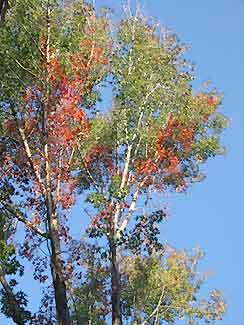| |
Trees - Autumn Colors
Why Do Leaves Change Color?
 Plant cells contain chlorophyll, which is green. They also contain tiny grains of yellow and red-orange plant pigments, carotenoids. The yellow pigment, xanthophyll, is also present in egg yolks. The red-orange pigment, carotene, gives carrots their orange color. We don’t see the color from these pigments during the summer because they are small and their color is hidden by the more prevalent chlorphyll. Plant cells contain chlorophyll, which is green. They also contain tiny grains of yellow and red-orange plant pigments, carotenoids. The yellow pigment, xanthophyll, is also present in egg yolks. The red-orange pigment, carotene, gives carrots their orange color. We don’t see the color from these pigments during the summer because they are small and their color is hidden by the more prevalent chlorphyll.
As daylight hours begin to shorten, changes take place in trees and they begin to prepare for the winter months. Chlorophyll is no longer needed for food production. It begins to break down and lose its color. This allows the carotenoids to show their colors. Leaves turn yellow or red-orange, the most common autumn colors.
Other pigments, anthocyanins, are linked with bright red, maroon, purple and blue colors. These pigments are not present in the leaves during the summer. In autumn, a layer of cells forms between the leaf and branch. This layer eventually stops the flow of water and nutrients into the leaf. It also prevents sugars from passing from the leaf to the tree. The rising amounts of sugars in the leaf combine with bright sunlight to form anthocyanins (water soluble pigments). The brightest red leaf contains the greatest amount of sugar. Soil characteristics also affect the pigments: acid soil produces bright reds and alkaline soil produces purples and blues.
Different combinations of these three pigments - chlorophyll, carotenoids and anthocyanins - result in the beautiful colors we enjoy seeing in autumn.
Key factors causing leaves to turn color are the lessening hours of light and a sudden cold snap. Leaves may be especially beautiful if there is plenty of rain in September followed by lots of sunny days and cold nights in October.
Tree examples in PWC include:
Common Name |
Botanical Name |
Autumn Colors |
Wildlife Connection |
| Tulip tree |
Liriodendron tulipifera |
bright yellow foliage |
seeds are eaten by squirrels and cardnals |
| Red Maple |
Acer Rubus |
red foliage |
seeds are eaten by wild turkey, squirrels, rabbits, porcupines and small rodents; twigs heavily browsed by deer; beavers use bark as food |
| Oaks |
Quercus sp. |
muted browns to reddish-orange foliage |
acorns are eaten by deer, raccoon, squirrels, rabbits, opossum and smaller rodents |
| Hornbeam |
Carpinus caroliniana |
orange and red |
beaver, squirrels and rabbits use the bark, buds or seeds |
| American Beech |
Fagus grandiflora |
muted yellows; leaves remain
on branches well into winter |
nuts are eaten by wild turkey, squirrels and racoons |
| Hickories |
Carya sp. |
muted yellows |
nuts are eaten by wood duck, wild turkey, jays, woodpeckers, squirrels; deer browse on twigs |
|
|